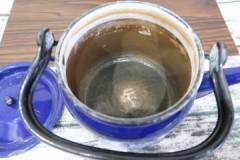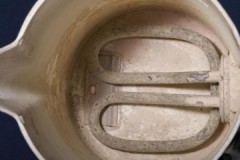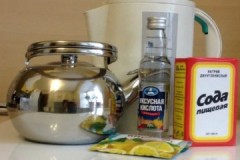Several effective recipes on how to descale a kettle with soda
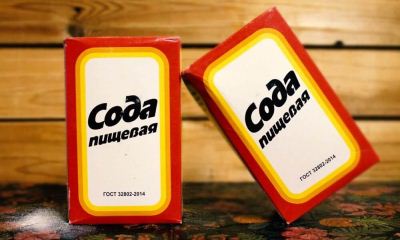 Regardless of what material the kettle is made of, over time, scale begins to appear on its walls.
Regardless of what material the kettle is made of, over time, scale begins to appear on its walls.
This is nothing more than undissolved salts and other trace elements present in large quantities in tap water.
It is impossible to ignore the problem of scale, because it not only gives boiled water a specific taste, increases the boiling time, but also significantly reduces the life of the household appliance.
How you can descale the kettle soda, we will tell in the article.
Content
Is it possible to clean, the pros and cons of the procedure
The cleaning properties of baking soda have been known for a long time. Sodium bicarbonate (aka sodium bicarbonate or in a simple way soda) dissolves in hot water, destroys limescale, removes unpleasant odors and disinfects the walls of the kettle.
Pros of using soda for cleaning the kettle:
- It not only cleans well, but also disinfects the surface.
- It is absolutely safe for health, does not emit toxic substances in contact with hot water.
- Soda, diluted with water, can be used as a mild abrasive that does not scratch the surface.
Of the negative characteristics, the insufficient effectiveness of soda in relation to old limescale deposits when used in its pure form is noted. In order to enhance the cleaning properties, the baking soda must be mixed with other ingredients (for example, salt or citric acid).
Home cleaning instructions
Algorithm of actions:
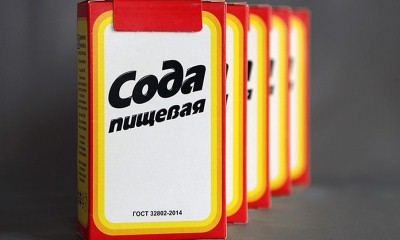 The kettle is half filled with water.
The kettle is half filled with water.- Fall asleep 2 tablespoons. baking soda (per liter of water)
- Bring the water to a boil, let the soda solution boil for thirty minutes over low heat.
- After the kettle is removed from the heat and left alone for two hours.
- Remove softened layers of limescale (you can use a hard sponge).
- Rinse the dishes with clean water.
When using baking soda to clean an eclectic kettle, the boil mode must be turned on at least three times.
With vinegar
Descaling with vinegar and baking soda is an effective method, but not very suitable for plastic, metal or ceramic appliances. It is used in the most extreme cases when other methods have not helped to achieve the desired cleanliness result.
Algorithm of actions:
- the kettle is filled with water, table vinegar and soda are added (based on 2 liters of water - 100 ml of vinegar solution and 1 tablespoon of soda powder);
- the dishes are left to soak for at least six hours (preferably overnight);
- after, the softened limescale is removed with a sponge;
- the kettle is thoroughly rinsed, changing the water several times.
With salt
At the same time, salt and soda will help get rid of limescale, both from the inside and from the outside.
Algorithm of actions:
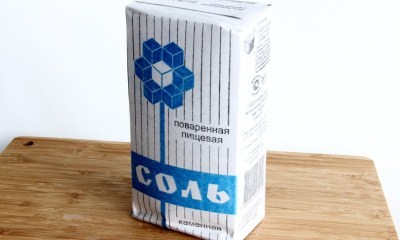 Prepare a cleaning solution. To do this, salt and soda are dissolved in water at the rate of 2 tbsp. dry ingredients per 1 liter of water.
Prepare a cleaning solution. To do this, salt and soda are dissolved in water at the rate of 2 tbsp. dry ingredients per 1 liter of water.- The kettle is filled with the prepared solution, and then lowered into a wide basin so that the composition covers it from all sides.
- Soda-saline solution is boiled for half an hour, after which the dishes are removed from the heat, cooled, rinsed with cold water.
After cleaning with salt, the dishes must be thoroughly wiped with a dry towel. Otherwise, whitish stains will remain on the surface.
With citric acid
Citric acid with baking soda will help to quickly remove limescale from the walls of electric, glass kettles.
It's simple:
- the dishes are filled with water, a sachet of citric acid powder and baking soda are added (calculation for 1 tablespoon of dry ingredients per 1 liter of liquid);
- boil water with citric acid and soda for at least ten minutes, after which the kettle is left alone for at least one hour;
- water, together with dissolved limescale particles, is poured into the sink.
With lemon and acetic acid
Acetic acid solution combined with fresh lemon wedges and baking soda - "heavy artillery" in the fight against old limescale deposits.
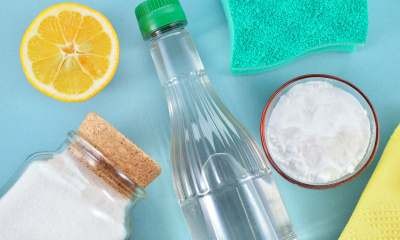 Algorithm of actions:
Algorithm of actions:
- In a liter of water, 4 tablespoons are diluted. vinegar and a few slices of fresh lemon, 2 tbsp. baking soda.
- The prepared solution is poured into a kettle and boiled for thirty minutes
- Remove the softened limescale layers with a soft sponge.
After the walls of the teapot are descaled, clean water is additionally boiled in it (preferably twice).
How often do you remove deposits?
Regular cleaning will help prevent excessive limescale build-up.
The frequency of cleaning is influenced by the quality of the water used... Pouring bottled or well-filtered water into the dishes can reduce the amount of cleaning to a minimum.
Features depending on the material
When choosing a method of descaling, it is important to consider the material of the kettle.
Enamelled surface
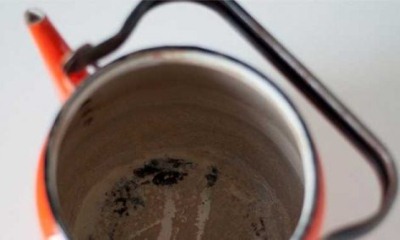 It is not recommended to clean enamel surfaces with citric acid alone or in combination with vinegar.
It is not recommended to clean enamel surfaces with citric acid alone or in combination with vinegar.
The thing is that acid thinns the enamel coating, which leads to a very rapid appearance of foci of rust and corrosion.
In addition, enamelled surfaces are easily scratched with free-flowing powders and other abrasive cleaning agents.
The most suitable means for removing limescale from enamelled surfaces are:
- sparkling water,
- special cleaning tablets,
- peeling potatoes or apples.
To prevent the enamel teapot from changing color during the cleaning process with carbonated water, it is necessary to use only colorless drinks (for example, mineral water).
Electric
Particular care should be taken when using citric acid... It's simple: an aggressive environment destroys rubber seals, thereby reducing the life of a household appliance.
Stainless steel
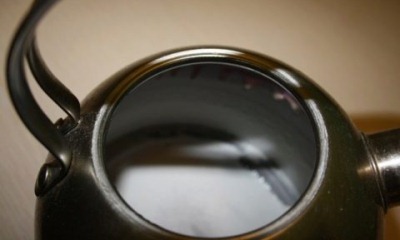 Citric acid, carbonated drinks will help to quickly clear a stainless steel kettle from limescale (it is not necessary to select soda without dyes).
Citric acid, carbonated drinks will help to quickly clear a stainless steel kettle from limescale (it is not necessary to select soda without dyes).
Take extra care when choosing abrasive detergents... Small particles perfectly remove limescale, but unfortunately leave scratches on the stainless steel gloss, which cannot be removed.
Ceramics
The main rule of cleaning ceramic dishes is that all actions must be extremely careful. Ceramics cannot withstand shocks, strong friction, and sudden changes in temperature.
The best way to clean your ceramic kettle is to use citric acid, soda, and household chemicals.
Glass
The original appearance of the glass teapot can only be preserved if it is regularly cleaned. Acetic water or special chemicals will help remove limescale..
Alternative remedies than to remove plaque
Descaling your kettle is easy. There are a huge number of folk remedies and special chemicals that help to clean quickly and efficiently.
Top 3 most popular folk remedies:
-
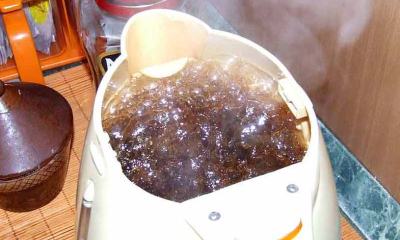 Sweet carbonated drinks... The composition of soda contains citric acid, which corrodes any, even very dense layer of limescale. The kettle is filled with sweet carbonated water and brought to a boil.
Sweet carbonated drinks... The composition of soda contains citric acid, which corrodes any, even very dense layer of limescale. The kettle is filled with sweet carbonated water and brought to a boil.After the boiled soda has cooled, the dishes are left alone for thirty minutes. The last stage - already cleaned surfaces are thoroughly washed with cold running water.
- Apple and potato peels... The container is filled with vegetable and fruit peels, after which it is poured with water and put on a fire to boil. After the cleaning has been boiled for five to ten minutes, the kettle is turned off and left alone for at least three hours. This time is enough for the scale to become soft and can be removed with a sponge.
- Aspirin tablets... It is enough to dissolve four aspirin tablets in 2 liters. water, pour the resulting liquid into the kettle. The solution with aspirin is boiled for at least thirty minutes, after which the walls are easily cleaned with a soft sponge.
Top 3 specialty descaling agents:
- Top House Cleaner... The 5% organic acid liquid will gently and quickly remove limescale deposits from the inner surface of a kettle or coffee machine. The liquid is odorless and does not cause allergic reactions in contact with skin. Manufacturer Germany. Average cost - 260 rubles. (500 ml bottle).
- Topperr 3031 - the concentrated product of the German manufacturer will clean the surfaces from limescale from the first time. Topperr 3031 will protect the walls of a kettle, coffee maker from rapid plaque formation. Concentrate cost - 140 rubles. (250 ml bottle).
- SANO Antikalk Kettle Descaler Gel effective for cleaning ceramic, glass, plastic teapots. Developed on the basis of phosphoric and sulfamic acid. Economical consumption and low cost make SANO Antikalk Kettle Descaler very popular among consumers. The average cost is 350 rubles. (700 ml bottle).
Advice
To ensure a quick and efficient descaling process, experts recommend using some tips:
 The most effective cleaning agents contain acid (citric acetic acid, fruit acid).
The most effective cleaning agents contain acid (citric acetic acid, fruit acid).- If it was not possible to clean the scale the first time, it must be gently rubbed with a scraper, and then cleaning again.
- After it has been possible to get rid of limescale, the kettle is filled with clean water and boiled again.These simple steps will help remove any cleaning agent residue.
Experienced housewives also recommend using only filtered water for boiling. In this case, the scale problem will occur much less frequently.
Conclusion
Cleaning the kettle from scale is a procedure, the regular implementation of which will help to maintain the appearance and extend the life of the household appliance. The correct use of baking soda will help restore sparkling cleanliness to the kettle.

